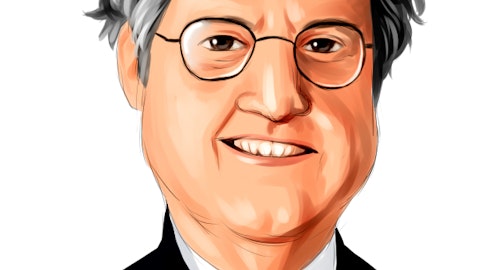John Pawlowski: Thanks. Good morning. Could you provide some more details on just domestic operator number one was 0.3 times coverage, what’s going on that operator? And have you or do you expect to give financial support to that operator through loans or rent abatements, rent deferrals?
Kevin Hann: The first answer to the last part of that question is no, we have not.
Rosa Hooper: And John, no, we have confidence in this operator in this particular market, which we’re not going to disclose the particular operator. But we do expect to see turnaround over the course of 2024.
Edward Aldag: And that particular operator just made significant investments in new facilities at that particular place that Rosa is referring to.
John Pawlowski: Okay. And so you don’t expect to give any financial support this year to that operator?
Rosa Hooper: No, it will not be needed.
John Pawlowski: Appreciate it. Last question for me. Steve, can you give us a sense for the average general acute care hospital in your portfolio right now, what type of secured financing you’d be able to get on those assets in terms of LTV rate? Any details would be appreciated.
Steven Hamner : We expect to be able to announce that. We hope relatively soon with to at least one of the transactions that we’ve been referring to, that is a secured financing transaction that’s included and those that are referred to as being under LOI and definitive document negotiation. But we’ll wait until we have something definitive to announce.
John Pawlowski: Okay. Thank you.
Operator: The next question comes from Tayo Okusanya from Deutsche Bank. Please go ahead.
Tayo Okusanya: Oh, yes. Good afternoon. Thank you for the time. In regards to the upcoming asset sales or the secured financing, could you just walk us through how you were unsecured, the syndicators of your line of credit, in particular, mean how they have to get involved in this in any way? I’m assuming just given there’s a large balance on the line of credit kind of looking at all this movement? And what kind of conversations do you have to have with them to make sure they’re comfortable with everything that’s going on?
Steven Hamner: So as we tried to walk you through a few minutes ago, as we complete these transactions, we will pay down the pending maturity starting with the $300 million in May, and excess until the next maturity will absolutely go to the bank group to the revolver. So, obviously, the bank lenders are very satisfied to see that.
Tayo Okusanya: Got you. Thank you.
Operator: The next question is a follow-up from Michael Carroll from RBC. Please go ahead.
Michael Carroll: Yeah, thanks. How tight are your financial covenants right now? And then how confident are you that you have the full access to your line of credit?
Steven Hamner: Fully confident. We have significant headroom in our own financial covenants either with the bank group or with the unsecured bond and interest.
Michael Carroll: And then Steve what is the covenant that’s the tightest I don’t know if you can provide any color on where it is today? Is it the interest coverage ratio? Is that the one that we should be looking at? And where is it at versus where it needs to be?
Steven Hamner: Yeah, that’s not a schedule we normally publish, but we have significant headroom in all of the covenants. The one you mentioned is certainly not an issue.
Michael Carroll: Okay. And then last one for me Steve is what is the assumed cap rate on the Prime purchase options on that remaining portfolio? So if they exercise those purchase options, I guess, what would the cap rate be on those sales?
Steven Hamner: I’d have to come back to you on that. I don’t have that right in front of me. But what I would point you to is if they exercise that option, it would be a $268 million — I’m sorry $260 million. And that includes, or let me put it this way the lease base on those assets is now $238 million. And that $238 million actually includes, I’m not sure we disclosed this but I will, $45 million in additional lease base that as part of this as Ed called it a comprehensive unified transaction was added to this new master lease. So all of that’s a long-winded way of saying the $260 million purchase price will represent almost $100 million gain on those assets. So I’m happy to come back to you on a cap rate basis, but I think that’s very, very indicative. The point in disclosing all that, again, is just to show the interest in the valuation that the market puts on these assets.
Michael Carroll: Okay, great. And then that $100 million gain that’s the depreciated booking and the other number you gave us was the gross book value of the assets?
Steven Hamner: That’s right.
Michael Carroll: Okay. Thank you.
Operator: The next question is a follow-up from Tayo Okusanya from Deutsche Bank. Please go ahead.
Tayo Okusanya: Yes. Thank you again. Just a quick one. I’m not sure if you talked about this and I apologize if you did, but the LTAC rent coverage going down to 1.1% with the most recent reporting versus one for the reporting before 119 [ph] a year ago. Is that all Earnest? Or is there something else going on there that you could talk about a little bit?
Edward Aldag: Yeah. No we’ve talked about this for the last few quarters. The reason for the decline in the LTAC is that the waivers that everybody had during COVID have obviously all gone away. We only own 15 LTAC, remaining all of the LTAC are have a parent guarantee or either cross-defaulted with IRFs that covers obviously much higher facilities. Of those 15 facilities, more than half of them are covering it more than 1.5 times.




